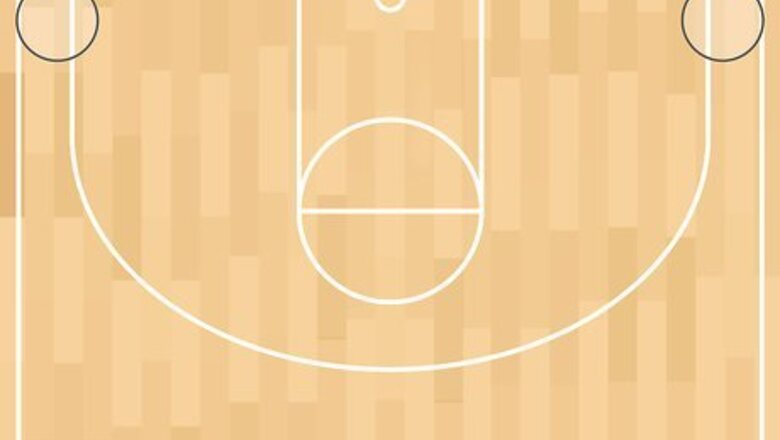
views
Moving into Position
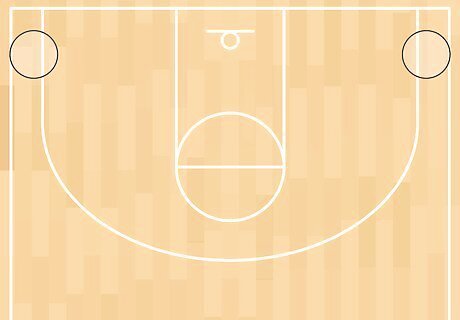
Get above the lower block, just outside the paint. You can post up from anywhere, but the lower block is ideal since you won’t get a 3-second violation in the paint and you’ll give yourself plenty of room to work. You can post up on either side of the floor. When your team gets the ball, try to get to the lower block before your point guard passes the half-court line to beat the defender to the spot. As a rule of thumb, the closer you are to the basket, the better. The shorter the distance between you and the basket, the easier your shot will be. If you’re playing in a recreational or youth league where they don’t have the 3-second violation rule, post up as close as you can to the rim or anywhere 1–2 feet (0.30–0.61 m) within the block. The paint refers to the area inside of the free throw lines. On most basketball courts, the paint is a different color to make things easier. The block refers to the two rectangles painted on the free throw lines near the bottom of the baseline. You can post up against a man-to-man or zone defense. It doesn’t necessarily matter, although it’s generally easier to score from the post if the opponent is playing man-to-man and you’re guarded by a smaller defender.
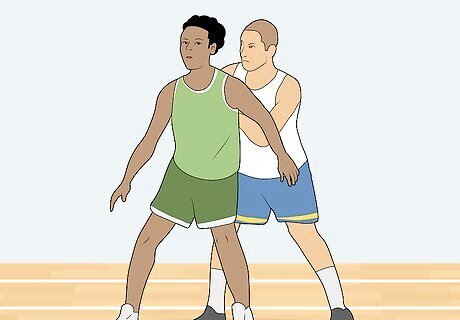
Slide in front of your defender and face the ball. When it looks like the ball is coming to your side of the floor or the preset play is starting to develop, get low and slide in front of your defender. Position yourself so that you are in between the defender and the ball. You may need to do a little pushing with your forearm or hip here. There’s no point to doing this earlier if the ball isn’t anywhere near you. If you go in too early, all you’re doing is taking yourself out of the play and giving your defender time to get into a better position.
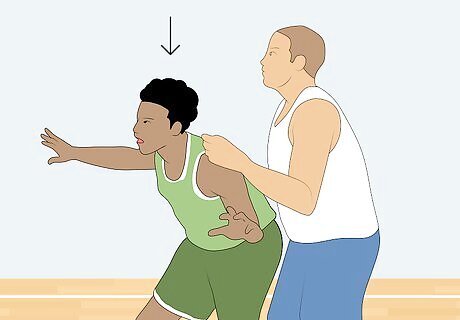
Stick your hips back, get low, and spread your arms out. Once you’re in front of the defender, push your hips out behind you and bend your knees. Put your arms out to your sides to feel the defender behind you and keep them from sliding in front. Keep the defender pinned at your back.Tip: This is nearly identical to the process of boxing a defender out when you’re rebounding. The only difference is you’re establishing position with your back to the basket. The lower you can get, the harder it will be for the defender to push you away from the basket.
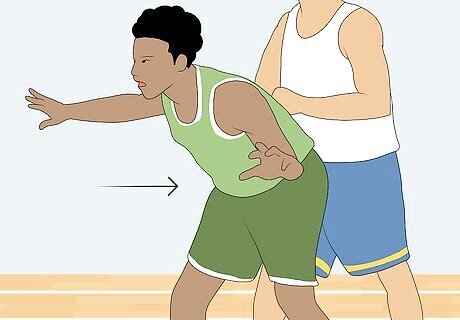
Move and use your weight to pin your defender back or to the side. Once the defender is on your back, they will try to move around your side to put a hand between you and the ball. Monitor where the opponent is on your back and shuffle your feet to one side or another to keep the defender behind you. If they move left, move left. If they go right, shuffle to your right. Continue doing this to maintain your position. If at any point you lose your position, you have two options. If you think you can overpower your defender, use your hip and arm to wrap around the front of your defender and reestablish your position. If they have you beat, just move and post up on the opposite block or go out to the 3-point arc and come back in to try again. Posting up is not always the right strategy. If you keep getting forced out of position, just accept that your defender is too good to be posted up and find another way to get open or contribute. You may have entire games where you won’t be able to post up depending on who you’re playing.
Getting the Ball
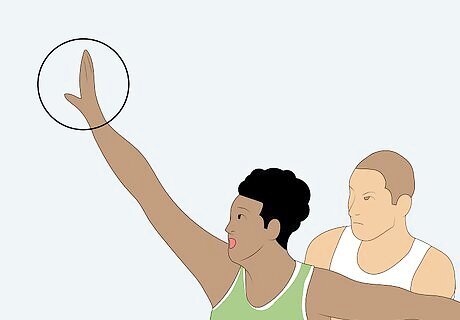
Raise a hand up to signal you’re in position for the ball. Once you’re in a good position and you have the defender pinned, put one of your hands up in the air and wave it back and forth to signal you want the ball. If your teammates don’t look at you, call out. Yell “post” or “ball” to let them know you want the ball. Use the hand on the opposite side of the defender. So if the defender is pinned on your left, put your right arm up and vice versa. If they’re directly behind you, raise either hand.
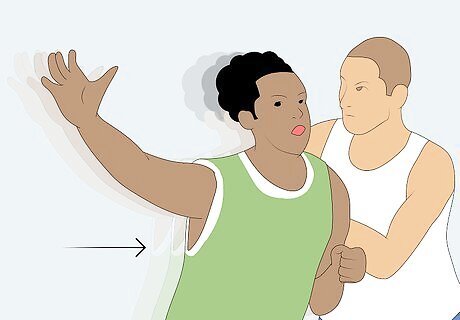
Continue pinning your defender back to stay open while you wait. If your teammate doesn’t pass to you immediately or they’re busy trying to create space for a pass, stay in front of the defender and push into them with your hips to keep them behind you. If you don’t keep them on your back, your defender may jump in front of you while the ball is in the air and steal it. Once you put your hand up, you must keep the opponent pinned. Use your hips, free arm, and legs to keep your opponent behind you. If they get in front of you, your teammate won’t be able to get you the ball safely.
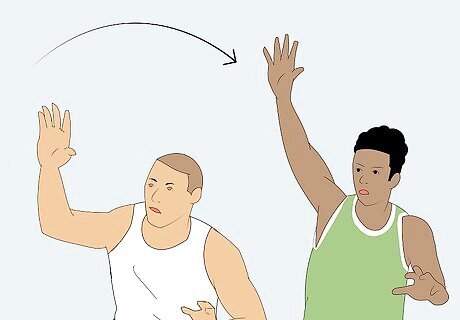
Turn and go behind the defender if they get in front of you. If at any point your defender gets in front of you and there’s at least 6 feet (1.8 m) behind you and the basket, change your tactic immediately and let you defender stay in front. Then, put your hand up behind you and look for a lob pass over the defender. If your teammate nails the pass, you’ll have a free layup waiting for you once you catch the ball.Tip: This specific move requires a quick reaction on your teammate’s part, so if they don’t pass the ball immediately, you’re better off working your way back in front of the defender. When done correctly, the ball shouldn’t be in your hands for more than 2 seconds once you catch it. This is kind of a unique move in the post since it’s the only post move where you aren’t actively trying to stay in front of the defender. It’s also the only post move where you’re basically setting up to score before you even have the ball. Usually, you wait to get the ball before you perform a post move. Do not push off of your opponent’s back to create space. This is a foul and it’s a pretty easy one for the refs to spot at that.
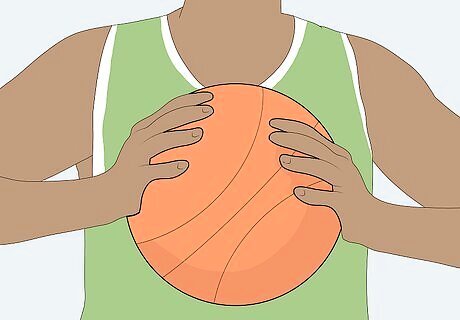
Catch the ball with both hands and pull it to your chest. Keep your knees bent to avoid losing your balance as the ball is coming in. Once your teammate passes the ball, catch it with both hands. As soon as you have possession, stick your elbows out and hold the ball tight against your chest to keep opponents from swiping it out of your hands. In basketball, a pass into the post is known as an entry pass. If you also play point guard, developing a strong set of entry passes is crucial if you want to put your team ahead. Always move to catch the ball if the pass is off the mark. If you have a choice between catching the ball with one hand and moving to catch the ball with both hands, move.
Scoring and Passing in the Post
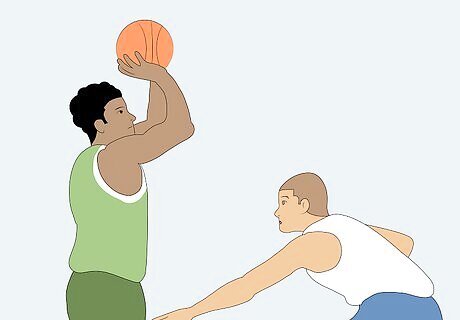
Turn to shoot immediately if the defender is out of position. If your defender went for a steal and missed, slipped, or just generally didn’t put themselves in a good position, turn and shoot immediately. Pivot on one foot away from the defender and towards the basket. Then, jump up and shoot the ball to score an easy two points. This doesn’t happen very often, especially if you’re older or playing against talented opponents. Still, it’s good to pay attention to the defender while you’re catching the ball to feel out these easy opportunities.
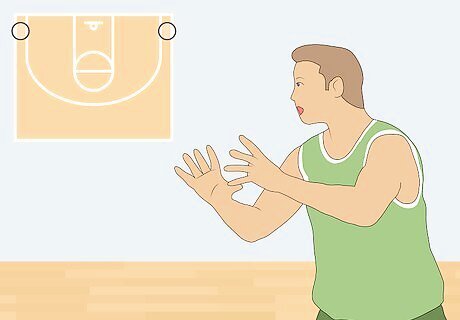
Locate your teammates on the wing to see if they’re wide open. With the ball at your chest, take a quick look around the floor. Spend 1-2 seconds looking at your teammates and mentally bookmark where they’re standing in case the defense collapses. If any of your teammates are wide open for a jumper, feel free to pass the ball.Tip: The hardest part about posting up is knowing when to pass the ball and when to take a shot. If you get the ball and 3 defenders run to you immediately, pass the ball to an open teammate. If you have an opening to score while they’re collapsing, it may be worth taking the shot. If the defense doesn’t collapse, you have time to assess your options and back the defender down. Often, the defenders will panic when the ball moves close to the rim and you’ll end up with 2-3 defenders moving your way. This creates space for your teammates to get open.
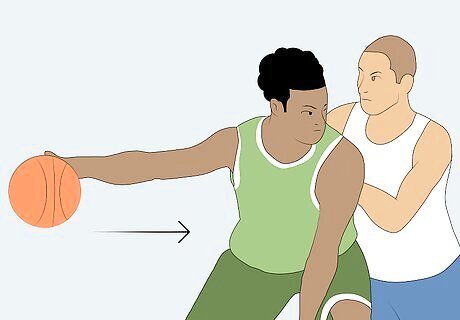
Back your opponent down by dribbling into them if you’re bigger. If you’re much bigger than your opponent or they look tired, get low and use short, powerful dribbles while pushing your weight into them to get closer to the basket. Continue pushing your way to the rim until you get into a good spot for a shot or the other defenders collapse and you can pass to a teammate. The post gets rough. Keep a strong shoulder up and get ready for contact whenever you get the ball. Posting up requires some grit and strength!
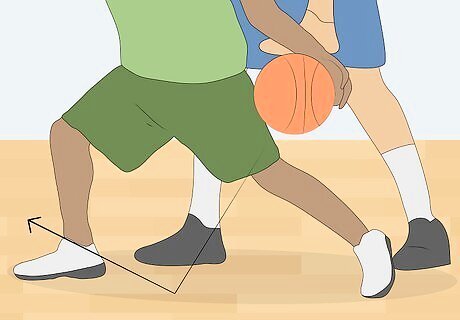
Drop-step to get around your defender and shoot. The drop step is the most common post move but it’s popular because it’s effective. Dribble once while wrapping one foot around the side of your defender and turn while jumping up towards the rim to shoot. The quick turn and shot off of one dribble will give you a great chance at scoring. The drop-step really is the bread and butter of any good post player. The key is to stay low, stick to one dribble, and drive your foot towards the rim quickly to keep your defender from making adjustments. This really only works if you can extend one of your feet around the opponent’s leg on that side. If you can’t get around them, you’ll end up jumping right into the defender.
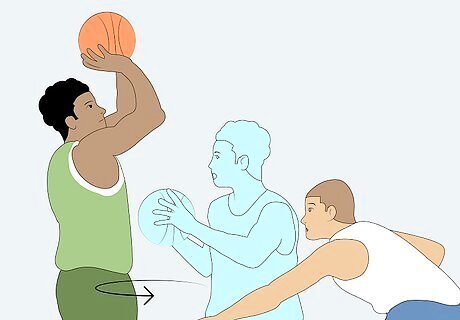
Pivot away from the defender to take a shot quickly if they’re playing off. If your defender is playing off, meaning that they’re giving you a little bit of space to work, pivot away from the rim and jump straight up to fire off a quick shot. This is a great option if you’re much faster than your defender since they won’t expect the quick jumper from the block. Pivoting and shooting is a smart move if you’re taller than your opponent but they’re much stronger than you. Use the glass! Jumpers from the block are pretty easy to miss if you go straight for the rim, but you almost always have the perfect angle to shoot off of the glass when you turn around on the block.

Dribble 1-2 times to create space if the lane is open. The lane refers to the middle of the floor. If there aren’t any defenders in the paint, dribble 1-2 times to get into the middle of the paint while keeping your back on the defender. If you can get to the middle, you’ll have more room to work by scoring on the right or left of the opponent. This is a particularly good option if you’re worried about getting pinned on the baseline. From the middle of the lane, you can take a jumper or go for an aggressive layup on either side. The goal of moving to the center is to create space for yourself to generate more options. Keep in mind, it’s harder to pass from the middle of the lane that it is to pass from the block since you’re probably going to be surrounded by defenders when you go to the middle.
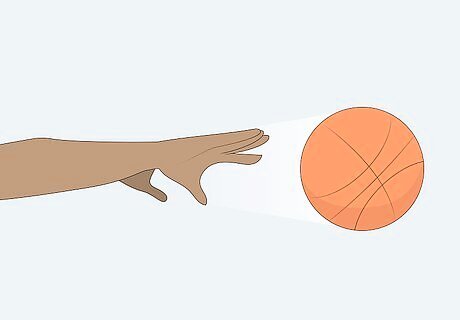
Pass the ball if someone else gets more open or the defense collapses. If at any point you end up with 2 or more defenders on you, look to pass to an open player. The goal of posting up is to create a pressure point on the defense that they’re forced to defend and you don’t always have to shoot!
Incorporating Advanced Post Moves
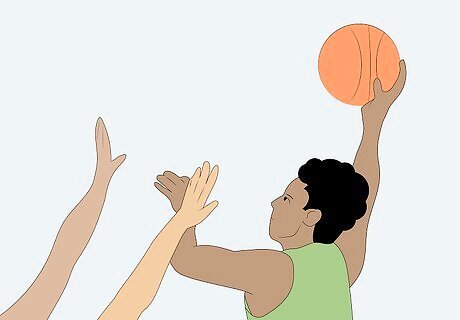
Use the jump hook to get over defenders and shoot in traffic. To do a jump hook, step to your side parallel to the basket. Jump off of your foot closest to the rim and jump up while lobbing the ball in an arcing motion over you defender with whichever arm is furthest from the rim. This is a great move to get over blockers and keep the ball from getting swatted out of your hands while you shoot. If you can get good at the jump hook, it’s a real game-changer. Many forwards and centers rely almost exclusively on jump hooks to score dozens of points a game. It’s just too hard to defend without fouling the shooter. Unfortunately, it takes a bit of practice to get the lobbing shot down.
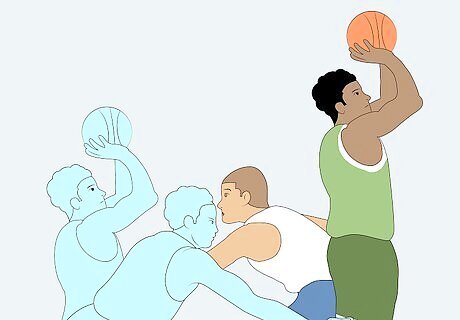
Pump fake after jump stopping to outwit the defender. To jump stop, dribble once and jump towards the basket. Land on both feet at the same time and then pump fake by pretending to shoot. This will throw the defender off guard and they may jump off of the floor. If they do, wait to jump until your opponent is on the way down to get a free shot off. If your opponent doesn’t jump, you can pivot or pump fake again to try to get into a better shooting position.

Spin across the defender if they overcompensate to block you. If you pivot to one side and the defender moves so quickly and so far that the other side becomes open, lift the ball above your head and pivot back in the other direction. Then, jump off while the defender is still on the other side to take a quick shot. This is a little risky since it involves lifting the ball off of your chest, but your defender will get a free swipe if you keep the ball near your chest while you’re doing this. Expect for this to work 3-4 times over the course of the game. Most defenders will only get burned a few times with the front spin before they start wising up.
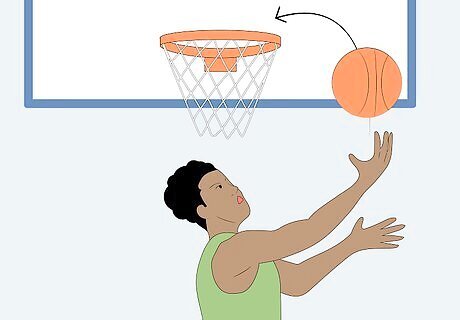
Go under the basket for a reverse layup if you’re pinned on the baseline. If you dribble and the defender pins you to the baseline or you catch the ball too close to the rim to get a good shot off, dribble under the basket along the baseline. Then, jump while you’re under the rim and let your momentum carry you to the other side of the rim. In mid-air, lay the ball up behind you off of the glass. This sounds a lot harder than it actually is. Just practice doing some reverse layups to get used to the feeling of shooting the ball up behind you.
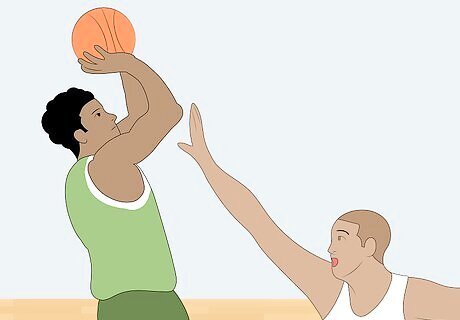
Opt for a fadeaway shot if you need to avoid a blocker. A fadeaway refers to a shot where you’re jumping away from the rim. If you pivot towards the basket and your opponent is completely in your face, jump up and away from the rim. Shoot a jumper and put a little more strength behind the shot to compensate for the angle of your jump. This is a great last-minute adjustment you can make to avoid getting a shot blocked. The fadeaway is a pretty hard move to pull off if you don’t have a lot of upper body strength. You typically don’t see this move from players under 15 since it requires a lot of coordination.
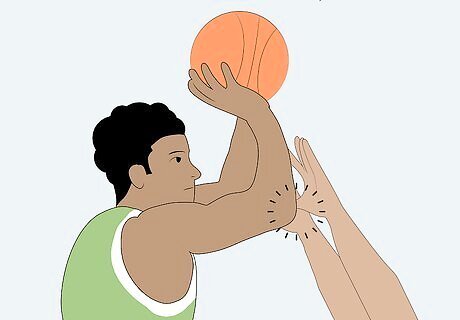
Shoot into the defender’s arms if the shot is low-percentage to draw a foul. If the defender did a good job with spacing and keeping their arms up and you feel like you’re probably going to miss or get blocked, move your arms to bump into your opponent’s arms to cause some contact. This may draw a foul and you may get a free two shots from the free-throw line if the refs call it!Warning: The referees won’t call this more than 2-3 times. Try to avoid doing this too often to keep the option open for when you really need it.












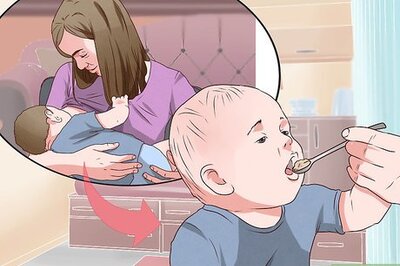
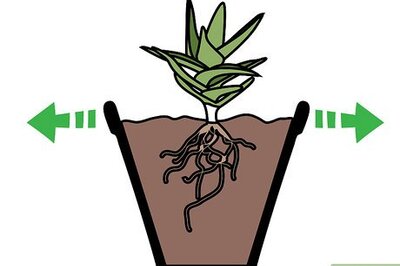




Comments
0 comment